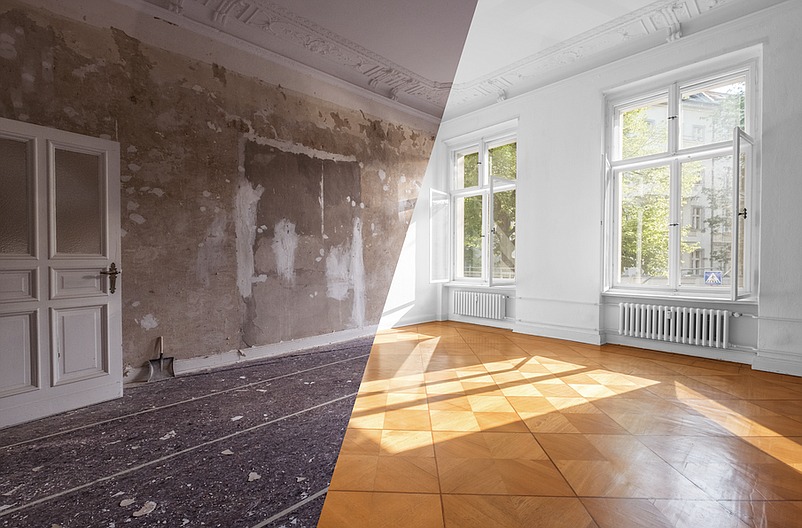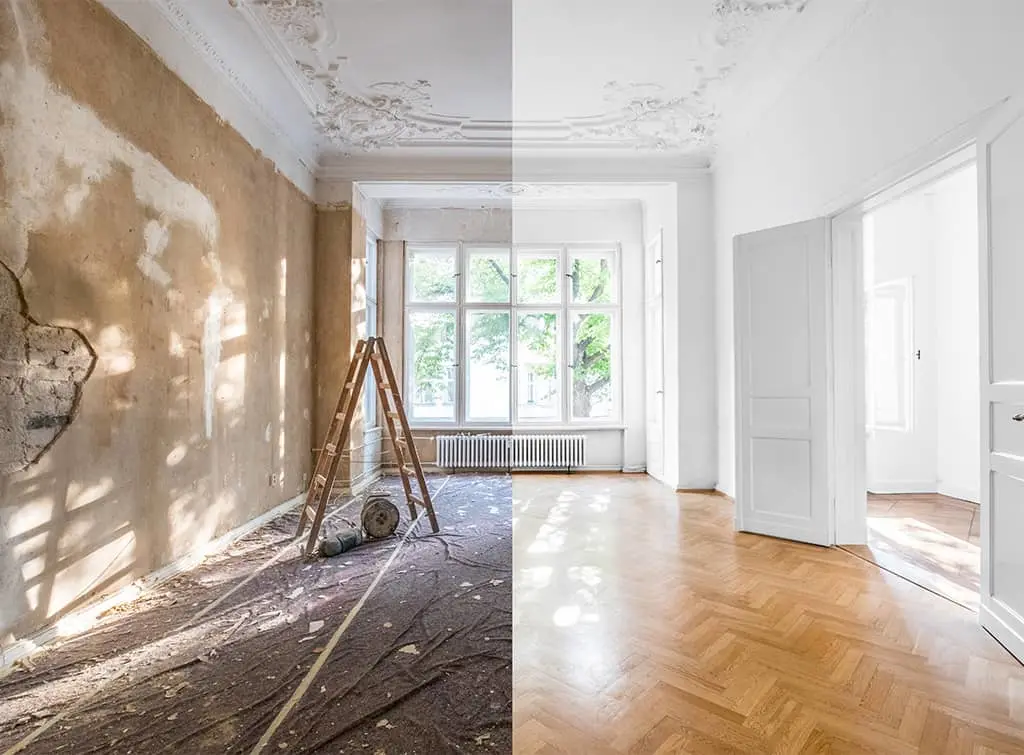
Full Home Renovation vs. Partial Remodel: What’s Right for You?
Introduction
When deciding between a full home renovation and a partial remodel, homeowners often struggle to balance budget, goals, and disruption. A renovation affects the entire property, while a remodel can focus on one or two rooms. Both can transform your living space, but each has very different implications in terms of cost, return on investment, and impact.
According to the National Association of Home Builders (NAHB), U.S. homeowners collectively spend over $600 billion annually on remodeling and renovation projects. Yet, not every project delivers the same results. In this guide, we’ll explore data-backed insights, explain the pros and cons of each approach, and help you decide which one best fits your needs.
Defining Full Renovation vs. Partial Remodel
A full home renovation involves updating or rebuilding multiple rooms—sometimes the entire property—often including layout changes, plumbing and electrical upgrades, new roofing, insulation, and complete interior redesign. It’s common for older homes or properties that haven’t been updated for decades.
A partial remodel, on the other hand, targets specific areas such as kitchens, bathrooms, or basements. The goal is to refresh, modernize, or improve functionality without tearing down the whole house.
According to Architectural Digest, a full home renovation typically costs between $15 and $250 per square foot, depending on materials and design complexity. Meanwhile, partial remodels are usually limited to one section—making them more affordable and faster to complete.
Why Homeowners Renovate or Remodel
Research from HomeAdvisor and the National Association of Realtors (NAR) shows that the top reasons homeowners renovate include:
-
Repairing damage or outdated systems (35%)
-
Improving comfort and livability (35%)
-
Enhancing aesthetics (32%)
-
Increasing property value (30%)
With rising housing prices, more families choose to remodel instead of moving. A 2024 survey by Clever Real Estate found that 63% of U.S. homeowners preferred upgrading their current home instead of buying new, due to high mortgage rates and limited housing supply.
However, the same survey revealed that 78% of projects go over budget and 46% face delays, mainly because of labor shortages and material price increases.
Cost Comparison: Full Renovation vs. Partial Remodel
1. Full Home Renovation Costs
A full renovation is a major investment. Data from HomeAdvisor and Houzz suggest that a typical full home renovation in the U.S. can cost anywhere from $100,000 to $300,000, depending on size and scope. Large-scale projects involving structural work, layout changes, and system replacements naturally cost more.
Average cost breakdown per square foot (2024 data):
-
Basic update: $15–$60/sq. ft.
-
Mid-range renovation: $60–$120/sq. ft.
-
Luxury renovation: $120–$250/sq. ft.
Most contractors recommend adding a 10–20% contingency for unforeseen issues such as wiring upgrades, plumbing replacements, or permit delays.
2. Partial Remodel Costs
A partial remodel is more budget-friendly and focused. According to Remodeling Magazine’s 2024 Cost vs. Value Report, average mid-range remodeling costs are:
-
Kitchen remodel: $26,000–$60,000
-
Bathroom remodel: $10,000–$25,000
-
Basement renovation: $20,000–$50,000
-
Room addition: $30,000–$80,000
The report also highlights that smaller, targeted remodels often deliver higher return on investment (ROI) percentages compared to large-scale projects.

Return on Investment (ROI)
According to the National Association of Realtors, the average ROI for common renovation projects is:
-
Minor kitchen remodel: 72–80%
-
Bathroom remodel: 60–70%
-
Window or siding replacement: 70–90%
-
Major kitchen renovation: 50–60%
The data shows that partial remodels typically recover a higher percentage of cost because they focus on visible improvements that appeal to buyers—like modern kitchens or bathrooms—while full renovations offer greater long-term comfort and functionality.
Time, Disruption, and Planning
One of the biggest challenges in renovation projects is managing disruption.
-
A full home renovation may take 4 to 8 months or more, depending on permits and materials. Some homeowners temporarily move out during construction.
-
A partial remodel, like a kitchen or bathroom update, usually takes 3 to 8 weeks, allowing you to live in the home while work continues.
Data from Houzz’s 2024 Renovation Barometer shows that 61% of homeowners underestimate project duration by at least 25%. Factors such as labor shortages, supply chain issues, and permit delays contribute to longer timelines.
For homeowners in Texas, local permit timelines can vary depending on the city. Working with an experienced contractor like SHT Tarrant ensures compliance with local building codes and efficient scheduling.
Which Is Right for You? Key Factors to Consider
1. Home Age and Condition
If your home is older than 25 years and suffers from structural issues, outdated wiring, or inefficient insulation, a full renovation might be necessary. It allows contractors to address deep-rooted problems instead of layering cosmetic fixes.
2. Budget and Financial Goals
Partial remodels are ideal when working with limited budgets. You can prioritize high-impact areas like the kitchen or bathroom first. For instance, updating your kitchen with modern fixtures can significantly increase home value while keeping costs contained.
3. Long-Term vs. Short-Term Stay
If you plan to stay in your home for 10+ years, investing in a full renovation offers better comfort, energy efficiency, and peace of mind. But if you plan to sell soon, focus on visible upgrades with higher ROI.
4. Resale Value
Real estate data from Zillow Research shows that homes with newly renovated kitchens sell up to 43% faster and for 6–10% higher prices than similar unrenovated homes. Small but visible changes often make the biggest market difference.
5. Lifestyle and Functionality
A full renovation lets you redesign the layout for better flow—combining spaces or adding extensions. A partial remodel focuses more on improving usability in specific rooms, such as replacing old cabinets or re-tiling a bathroom.
Advantages of Full Home Renovation
-
Complete Transformation – Enables you to modernize structure, layout, and design all at once.
-
Energy Efficiency – Updating insulation, HVAC, and windows can lower utility bills by 15–30%. (U.S. Department of Energy)
-
Increased Property Value – Adds long-term equity and can make the home more competitive in the market.
-
Better Layout and Flow – Ideal for older homes with segmented rooms or outdated designs.
-
Future-Proofing – You can integrate smart home systems, renewable energy, and sustainable materials.
Advantages of Partial Remodel
-
Budget Control – Costs are predictable and more manageable.
-
Less Disruption – You can live in your home during most partial remodels.
-
Faster Turnaround – Shorter timelines mean quicker satisfaction.
-
Targeted ROI – Investing in kitchens or bathrooms can deliver strong resale gains.
-
Flexibility – You can remodel in phases as your budget allows.
Potential Drawbacks
| Aspect | Full Home Renovation | Partial Remodel |
|---|---|---|
| Cost | High | Lower |
| Timeline | Long (4–8 months) | Short (2–8 weeks) |
| Disruption | Major | Minimal |
| Risk of Overcapitalization | Higher | Lower |
| Scope | Whole property | Selected rooms |
| ROI % | Moderate (50–70%) | High (60–90%) |
Practical Example
Let’s take two realistic cases.
Case 1: Full Renovation (2,000 sq ft home)
-
Mid-range cost: $200,000
-
Duration: 6 months
-
ROI: 60%
-
Total recovered value: ~$120,000
-
Ideal for: Older homes with outdated structure, poor insulation, or layout inefficiency.
Case 2: Partial Remodel (Kitchen + Bath)
-
Kitchen: $45,000
-
Bathroom: $18,000
-
Duration: 6 weeks
-
ROI: 75%
-
Total recovered value: ~$47,250
-
Ideal for: Modern homes needing visual upgrades before sale.
Sustainability and Efficiency Considerations
Modern renovations focus not only on looks but also on sustainability. According to the U.S. Green Building Council, energy-efficient retrofits can reduce energy use by up to 25–35% in older homes. Using recycled materials, LED lighting, and water-saving fixtures can further enhance long-term savings.
Full renovations allow comprehensive upgrades like solar panels, advanced HVAC systems, or new insulation. However, even a partial remodel can improve sustainability—for instance, replacing faucets and toilets with low-flow models or switching to ENERGY STAR appliances.
The Emotional Factor
The National Association of Realtors’ Remodeling Impact Report includes a “Joy Score” that measures homeowner satisfaction post-renovation.
-
Kitchen remodels scored 9.8/10.
-
Bathroom remodels scored 9.6/10.
-
Whole-house renovations scored 10/10, reflecting the emotional satisfaction of a completely renewed home.
These numbers show that while partial remodels are cost-effective, full renovations provide unmatched fulfillment for long-term homeowners.
How SHT Tarrant Helps You Decide
At SHT Tarrant, homeowners across Texas get end-to-end remodeling solutions—ranging from full home renovations to custom room remodels.
-
If you’re looking to refresh your kitchen, explore our Kitchen Remodeling services for modern designs and durable finishes.
-
For targeted updates, our Bathroom Remodeling team can transform old spaces into spa-style comfort zones.
-
Planning to expand your living space? Check out Home Additions for structural expansions.
-
And for full-scale coordination, our General Contracting service manages design, materials, and permits from start to finish.
Whether you choose a full or partial project, our goal is to balance budget, quality, and comfort with professional guidance and transparent planning.
Decision Checklist
Before starting, review this checklist to decide which path is right for you:
-
Define your goal: comfort, resale value, or modernization?
-
Evaluate your home’s current condition.
-
Set a clear, realistic budget.
-
Estimate how long you can handle disruption.
-
Get multiple estimates from licensed contractors.
-
Include contingency (10–20%) for hidden costs.
-
Ask about warranties and materials sourcing.
-
Phase your remodel if needed.
This process ensures you make an informed, financially smart decision—backed by data and professional advice.
Final Thoughts
Choosing between a full home renovation and a partial remodel depends on your priorities.
If you want to transform every aspect of your home for long-term living, a full renovation provides lasting comfort and value.
If you’re focused on quick upgrades or selling soon, a partial remodel delivers strong ROI with less disruption.
In both cases, success depends on proper planning, realistic budgeting, and skilled execution. Working with trusted professionals like SHT Tarrant ensures your project is completed on time, on budget, and with exceptional results.
